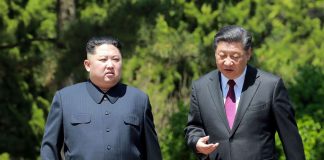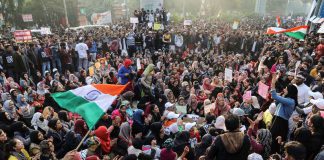JUNE 14, 2018

WASHINGTON, D.C. – Some of the most intense drama surrounding President Trump’s summit with North Korean leader Kim Jong Un came not across the negotiating table, but in the days and hours leading up to Tuesday’s historic meeting — a behind-the-scenes flurry of commotion prompted by Trump himself.
After arriving in Singapore on Sunday, an antsy and bored Trump urged his aides to demand that the meeting with Kim be pushed up by a day — to Monday — and had to be talked out of altering the long-planned and carefully negotiated summit date on the fly, according to two people familiar with preparations for the event.
“We’re here now,” the president said, according to the people. “Why can’t we just do it?”
Trump’s impatience, coupled with a tense staff-level meeting between the two sides on Sunday, left some aides fearful that the entire summit might be in peril.
Ultimately, Secretary of State Mike Pompeo and White House press secretary Sarah Huckabee Sanders persuaded Trump to stick with the original plan, arguing that the president and his team could use the time to prepare, people familiar with the talks said. They also warned him that he might sacrifice wall-to-wall television coverage of his summit if he abruptly moved the long-planned date to Monday in Singapore, which would be Sunday night in the United States.
The debate, which has not previously been reported, underscores the ad-hoc nature of the summit, which was abruptly announced, called off and then reinstated all before either leader had touched down in Singapore.
The pageantry and spectacle surrounding the first meeting between a U.S. president and a leader of North Korea’s autocratic regime also obscured the fact that the North Koreans agreed to little in the way of specific or tangible concessions. Although Kim said he was committed to the “complete denuclearization of the Korean Peninsula,” the joint statement between the two leaders included no timetable for when or how North Korea would reveal, destroy and allow verification of its nuclear arsenal.
Harry Kazianis, the director of defense studies at the Center for the National Interest, described the Singapore extravaganza as “21st-century diplomacy” with a Trumpian twist.
 U.S. President Donald Trump and North Korea’s leader Kim Jong Un meet in a one-on-one bilateral session at the start of their summit at the Capella Hotel on the resort island of Sentosa, Singapore June 12, 2018. Picture taken om June 12, 2018 – REUTERS/Jonathan Ernst
U.S. President Donald Trump and North Korea’s leader Kim Jong Un meet in a one-on-one bilateral session at the start of their summit at the Capella Hotel on the resort island of Sentosa, Singapore June 12, 2018. Picture taken om June 12, 2018 – REUTERS/Jonathan Ernst
“It felt more reality TV than it did an old school 1980s, Cold War summit,” Kazianis said. “Trump is going to do it differently. He’s going to do it in a media-savvy way. The very long handshakes, the long corridor walks — it’s all his distinct way.”
At one point, after watching North Korean television, which is entirely state-run, the president talked about how positive the female North Korean news anchor was toward Kim, according to two people familiar with his remarks. He joked that even the administration-friendly Fox News was not as lavish in its praise as the state TV anchor, one of the people added, and that maybe she should get a job on U.S. television, instead.
At another point, Trump marveled at how “tough” the North Korean guards seemed, noting that they were always stone-faced and refused to shake hands, the two people said. One recalled the president joking that they could likely take on White House Chief of Staff John F. Kelly, a retired four-star Marine general. A second did not remember the president specifically mentioning Kelly, but just noting more generally that Kim’s guards seemed formidable.
A North Korean government video released Thursday shows Trump returning the salute of a North Korean general, drawing criticism from those who saw it as feeding Pyongyang’s propaganda.
Retired Navy Rear Adm. John Kirby, a former spokesman for both the Defense and State departments, called the image “striking.” Kirby told CNN it was “inappropriate from a protocol perspective,” and “you most certainly don’t do it with the leaders of foreign militaries of an adversary nation.” After exchanging salutes, the two men shook hands.
Behind the scenes before the summit, other dynamics were also unfolding.
The language in the agreement that Trump announced with Kim, for instance, was almost entirely prewritten before Trump arrived in Singapore — a standard diplomatic practice for leaders’ meetings, which are normally preceded by extensive negotiations and discussions between lower-level officials.
But Trump repeatedly asserted that the final agreement was based on his ability to size up Kim in person and build a working relationship with him. “We got to know each other well in a very confined period of time,” the president told reporters on Tuesday. “I know when somebody wants to deal and I know when somebody doesn’t.”
While some negotiations did continue once on the ground in Singapore, nearly all of the terms — including North Korea’s vague commitment to denuclearize — were part of scripted talking points the leaders could cite as agreement. At least three of the four pledges listed in the Kim-Trump statement were agreed to before Trump’s arrival, according to a person familiar with the negotiations: to jointly work toward denuclearization of the Korean Peninsula; toward a peaceful and stable bilateral relationship; and toward a lasting and stable peace on the peninsula.
Trump appeared to allude to that process in his news conference Tuesday. The 1½ -page joint statement, he said, was “not something that just happened to be put together. This was done over months.” Yet at the same time, the president said, there was “much, much more” that was agreed upon but not included in the final document because “we didn’t have time.”
Based on Trump’s comments to the media, it was difficult to tell what had been agreed to ahead of time, what was on the agenda for the summit and what had not been agreed to at all. Earlier negotiations between North Korean officials and Pompeo included discussions of Pyongyang’s long-standing insistence that the United States dial back or cancel its annual military exercises with South Korea. Although that was not mentioned in the signed document, Trump announced that he had agreed to it.
As part of creating a personal rapport with Kim, Trump also privately talked about wanting to extend an unusual olive branch to the North Korean leader: The president suggested he might be able to orchestrate a meeting or proposal with some of his real estate developer and financier friends, who could bring lucrative development deals to Kim’s country. It is unclear whether he ended up mentioning the idea to Kim.
Sen. Lindsey O. Graham (R-S.C.), who spoke with Trump as he flew home from Singapore on Air Force One, said the president was simply being his natural “salesman” self.
“He is selling condos, that’s what he is doing,” Graham said. “He’s approaching North Korea as a distressed property with a cash-flow problem. Here’s how we can fix it.”
In a news conference Tuesday before departing Singapore, Trump hinted at his dreams of real estate diplomacy, noting that he had played Kim a video — derided by some as more akin to North Korean propaganda than the work of the president’s National Security Council — to show him the possibilities of a deal with the West.
“As an example, they have great beaches,” Trump said. “You see that whenever they’re exploding their cannons into the ocean, right? I said, ‘Boy, look at the view. Wouldn’t that make a great condo behind?’ ”
The president continued: “You could have the best hotels in the world right there. Think of it from a real estate perspective.”
There were other challenges and unexpected twists, as well. After watching former NBA star Dennis Rodman, who also flew to Singapore for the occasion, praise him on television, Trump dispatched Sanders to call Rodman to thank him for his kind words, a White House official said.
“He called, his secretary and she called me and said, ‘Dennis, Donald Trump is so proud of you, and he thanks you a lot,’” Rodman told CNN.
And in the pre-summit negotiations, one official said, the administration found itself in the unusual position of trying to explain to the North Korean regime — which has no free press — why Trump could not just leave the White House press corps behind in Washington.
Louise Sunshine, a former longtime executive at the Trump Organization, laughingly described the summit as “like watching a reality TV show,” before adding that the president “deserves a lot of credit” for simply brokering a face-to-face meeting with Kim.
“Donald represents the concept,” she said. “His focus was on creating eye contact, a bond, a relationship. I don’t think he was there to negotiate. He was there to create a relationship. It was all about the relationship.”
Courtesy/Source: Washington Post










































































































